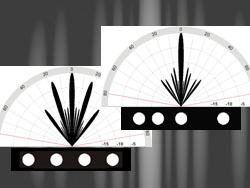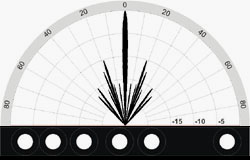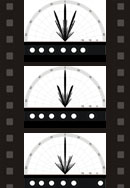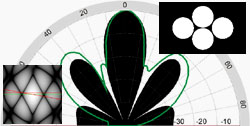 |
|||||
| Thinned
Array Sidescan Sonar |
|||||
| |
|||||
|
|||||
| By mounting
individual Sonar Transducers in a line, one gets an array that in some,
but not all aspects, behaves like one long Sidescan Sonar Transducer.
This so called "Thinned Array" can be optimized by mounting the
individual transducers not in an evenly spaced array, but finding an
optimum configuration by simulating and fine-tuning the array. This is demonstrated here for the popular example of building a Sidescan Sonar Transducer out of individual Fishfinder Sonar Sounders. By optimizing the array instead of mounting the Transducers in the classical, evenly spaced array, distinct improvements are possible. |
|||||
|
January 2007
Recent
simulations of my four-transducer design, carried out at the Hjemmesider ved Institutt for
informatikk at the University of Oslo,
give less optimistic results for the unevenly
spaced array. Folllowing these results, the unevenly spaced array
should still be better than an evenly spaced one of the same
length, but the sidelobe suppression is less than in my simulations.What I still miss is a possibility of comparison for simulations and measurements on such an array with the physical data exactly known. This comparison suggests a reasonably good agreement of theory and experiment, but bases on somewhat uncertain geometrical data for the real transducer. |
|||||
|
|
|||||
|
|||||
|
|
|||||
|
|||||
|
|
|||||
|
|||||
|
|
|||||
|
|||||
|
|
|||||
| An important advice: If you plan to work with a sidescan sonar unit, please keep in mind, that these homebuild fishfinder sidescan systems will never reach the picture quality of a professional system. They are just good enough for getting a taste of running a sidescan and for a coarse orientation on the bottom of the lake or sea you are investigating. They are good for running a sidescan as a hobby, and it may be a lot of fun using it, but if the success of an expensive project depends on the quality of the sonar data you will obtain, you should use a professional system. |
|||||
| Links: |
|||||
| Homebuild Fishfinder Sidescan Sonar: This page from Dan Fountain shows how to build a sidescan sonar on the basis of a fishfinder and some results obtained on a wreck in the great lakes. It has also a lot of interesting links. This page as well as the sidescan sonar forum inspired me to simulate some fishfinder sonar transducer to see if they can be optimised. Homebuild professional Sidescan Sonar: Sture Hultqvist has build some very nice sidescan sonar systems. In combination with his experience, the data he obtained with his own, as well as with some commercial ones, rank among the finest you can find on the web. Many interesting links for instance about wrecks in Scandinavia. Geotech Sidescan Sonar Forum Shipwreck World with Sidescan Sonar Forum |
|||||
| |
|||||
| |



